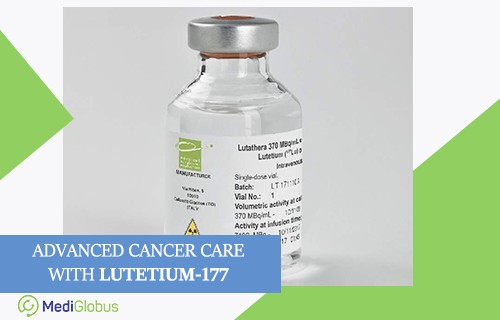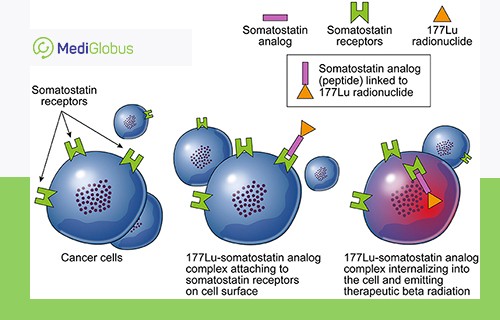According to the WHO, in 2018 more than 9 million people died from cancer. 10% of that number accounts for prostate cancer. In the early stages, it is completely curable, but in stage 4 the 5-year survival rate is only 30%. Therapy with the isotope Lutetium-177 can prolong a patient’s life. Medical facilities started using it in 2010. In 10 years, it has proven to be effective in treating late-stage prostate cancer. It increases the survival rate by 20%. The method is also used to treat 4th stage neuroendocrine tumors.
What is Lutetium-177 therapy?

Therapy with Lutetium-177 is also called membrane-specific antigen therapy. It is prescribed to 4th stage cancer patients. Using this method, one can: (1) make the tumor smaller and, therefore, more operable; (2) prevent the cancerous cells from spreading to other organs and systems; (3) lessen the symptoms.
Patients receive the treatment to stop the metastases, or if other methods of treatment have already failed. For some, Lutetium-177 may case prolonged remission.
Therapy with Lutetium-177 is aimed at treating 2 types of 4th stage cancer:
prostate cancer (PSMA therapy);
neuroendocrine tumors (PRRT-therapy).
How safe is Lutetium-177 therapy?
Lutetium-177 is capable of damaging and destroying cancer cells. Moving towards the tumor sites, it targets malignant cells. However, on its way, it enters salivary and tears glands, as well as kidneys and small intestine. Those organs may suffer from minimal side-effects.
Among such side effects are abdominal pain, nausea, vomiting, and rarely – hair loss. Lutetium-177 is toxic to kidneys and bone marrow.
Despite that, the patients’ life quality noticeably improves. Their pain is relieved, the size of the lesion is reduced and they can partially return to their daily activities.
How does PSMA therapy with Lutetium-177 work?
The main aim of the therapy is PSMA receptors. They can be found in the malignant tissue of prostate cancer, and also in other organs where metastases have begun. PSMA receptors interact with PSMA molecules, binding themselves to them, like a jigsaw. However, radioactive Lutetium-177 can connect itself to the PSMA molecule. Therefore, wherever PSMA molecule travels – which is cancerous sites – it carries radiation with it, damaging the structure of tumor tissue. Because of that, the body’s exposure to radiation is much more limited, in comparison to other methods.
How does Lutetium-177 therapy work with neuroendocrine tumors?

Neuroendocrine tumors are usually found in the stomach, intestines, and the breathing tract. The symptoms caused by cancer-receptors interactions, specifically, somatostatin. One can ease the symptoms by activating them. Receptors are activated either by a molecule of the same type or by any similar molecule – which is, in our case, Lutetium-177 isotope.
This treatment was recently approved for use by the FDA in 2018. It is recommended
to patients with somatostatin-sensitive receptors, whose bone marrow and kidneys are healthy. As of now, this is the only effective method of prolonging a late cancer patient’s life.
During treatment, the patient is injected with a substance that is similar in composition to the somatostatin hormone. Before that, the molecule is bound to the Lutetium-177 isotope. When it enters the body, it goes straight to the source of the tumor. Because it resembles somatostatin, the receptors of the cancer cell let it through together with the radioactive isotope. This is how Lutetium-177 gets inside the cancer cell and destroys it from within.
The survival rate of patients undergoing Lutetium-177 therapy
Lutetium-177 isotope therapy increases life longevity. Johnath Strossberg, American oncologist and researches, discovered that Lutetium-177 therapy has increased 3-year survival rate in 62% of his patients with stage 4 middle colon cancer. Without this therapy, only 10% of people with the same diagnosis have lived for 3 years.
Patients at stage 4 of prostate cancer commonly have 9-12 months to live. Therapy with Lutetium-177 significantly improves their survival: in 64% of patients, the size of the tumor has decreased by more than a half. The life expectancy of patients after PSMA therapy with Lutetium-177 has increased by 50%.
How much does Lutetium-177 therapy cost and which clinics provide it?
Therapy with Lutetium-177 can only be done in the most advanced hospitals. Many third-world clinics do not have FDA approval to use this method. The average price of Lutetium-177 therapy is $10,000 per course. A person in the last stages of cancer should undergo 3-4 of such courses.
The cheapest therapy is in Turkey, starting from $8,000. You can get it at Liv, Memorial, Medical Park clinics.
Therapy with Lutetium-177 is the only chance for late-stage cancer patients. In this situation, any delay may be fatal. MediGlobus will help you sign up for the clinic and receive treatment. Write to us and we will answer your questions and arrange a medical trip.






Comments